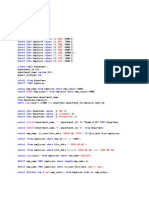SQL_Scripts_Window_Function_Part1
Uploaded by
abhikumbhar1908SQL_Scripts_Window_Function_Part1
Uploaded by
abhikumbhar1908drop table employee;
create table employee
( emp_ID int
, emp_NAME varchar(50)
, DEPT_NAME varchar(50)
, SALARY int);
insert into employee values(101, 'Mohan', 'Admin', 4000);
insert into employee values(102, 'Rajkumar', 'HR', 3000);
insert into employee values(103, 'Akbar', 'IT', 4000);
insert into employee values(104, 'Dorvin', 'Finance', 6500);
insert into employee values(105, 'Rohit', 'HR', 3000);
insert into employee values(106, 'Rajesh', 'Finance', 5000);
insert into employee values(107, 'Preet', 'HR', 7000);
insert into employee values(108, 'Maryam', 'Admin', 4000);
insert into employee values(109, 'Sanjay', 'IT', 6500);
insert into employee values(110, 'Vasudha', 'IT', 7000);
insert into employee values(111, 'Melinda', 'IT', 8000);
insert into employee values(112, 'Komal', 'IT', 10000);
insert into employee values(113, 'Gautham', 'Admin', 2000);
insert into employee values(114, 'Manisha', 'HR', 3000);
insert into employee values(115, 'Chandni', 'IT', 4500);
insert into employee values(116, 'Satya', 'Finance', 6500);
insert into employee values(117, 'Adarsh', 'HR', 3500);
insert into employee values(118, 'Tejaswi', 'Finance', 5500);
insert into employee values(119, 'Cory', 'HR', 8000);
insert into employee values(120, 'Monica', 'Admin', 5000);
insert into employee values(121, 'Rosalin', 'IT', 6000);
insert into employee values(122, 'Ibrahim', 'IT', 8000);
insert into employee values(123, 'Vikram', 'IT', 8000);
insert into employee values(124, 'Dheeraj', 'IT', 11000);
COMMIT;
/* **************
Video Summary
************** */
select * from employee;
-- Using Aggregate function as Window Function
-- Without window function, SQL will reduce the no of records.
select dept_name, max(salary) from employee
group by dept_name;
-- By using MAX as an window function, SQL will not reduce records but the result
will be shown corresponding to each record.
select e.*,
max(salary) over(partition by dept_name) as max_salary
from employee e;
-- row_number(), rank() and dense_rank()
select e.*,
row_number() over(partition by dept_name) as rn
from employee e;
-- Fetch the first 2 employees from each department to join the company.
select * from (
select e.*,
row_number() over(partition by dept_name order by emp_id) as rn
from employee e) x
where x.rn < 3;
-- Fetch the top 3 employees in each department earning the max salary.
select * from (
select e.*,
rank() over(partition by dept_name order by salary desc) as rnk
from employee e) x
where x.rnk < 4;
-- Checking the different between rank, dense_rnk and row_number window functions:
select e.*,
rank() over(partition by dept_name order by salary desc) as rnk,
dense_rank() over(partition by dept_name order by salary desc) as dense_rnk,
row_number() over(partition by dept_name order by salary desc) as rn
from employee e;
-- lead and lag
-- fetch a query to display if the salary of an employee is higher, lower or equal
to the previous employee.
select e.*,
lag(salary) over(partition by dept_name order by emp_id) as prev_empl_sal,
case when e.salary > lag(salary) over(partition by dept_name order by emp_id) then
'Higher than previous employee'
when e.salary < lag(salary) over(partition by dept_name order by emp_id) then
'Lower than previous employee'
when e.salary = lag(salary) over(partition by dept_name order by emp_id)
then 'Same than previous employee' end as sal_range
from employee e;
-- Similarly using lead function to see how it is different from lag.
select e.*,
lag(salary) over(partition by dept_name order by emp_id) as prev_empl_sal,
lead(salary) over(partition by dept_name order by emp_id) as next_empl_sal
from employee e;
You might also like
- 20 SQL Exercises For Practice: Table Structure and Schema100% (5)20 SQL Exercises For Practice: Table Structure and Schema12 pages
- Synchronouus MachinesElectrical Machines - 526-746No ratings yetSynchronouus MachinesElectrical Machines - 526-746221 pages
- Database Management System Practical SQLNo ratings yetDatabase Management System Practical SQL7 pages
- Operators Operators & & Functions FunctionsNo ratings yetOperators Operators & & Functions Functions29 pages
- EXP - 3 Nishkarsh Maitry RA1811003010422: OutputNo ratings yetEXP - 3 Nishkarsh Maitry RA1811003010422: Output6 pages
- Employee Table: Practical QUERIES (1-10)No ratings yetEmployee Table: Practical QUERIES (1-10)7 pages
- ORACLE Fundamental - SQL 1 آاروأ أ: Moh&AliNo ratings yetORACLE Fundamental - SQL 1 آاروأ أ: Moh&Ali4 pages
- Grigoras, Smith, Morrison, Enzinger (2013) Forensic Audio Analysis - Review 2010-2013No ratings yetGrigoras, Smith, Morrison, Enzinger (2013) Forensic Audio Analysis - Review 2010-201328 pages
- Bioreactor Systems: For Rapid Bioprocess DevelopmentNo ratings yetBioreactor Systems: For Rapid Bioprocess Development8 pages
- Nusrat Jahan Lecturer (Grade-I) Department of Civil Engineering Ahsanullah University of Science & TechnologyNo ratings yetNusrat Jahan Lecturer (Grade-I) Department of Civil Engineering Ahsanullah University of Science & Technology34 pages
- Ee6008 - Microcontroller Based System DesignNo ratings yetEe6008 - Microcontroller Based System Design91 pages
- Engineers' Cax Education-It'S Not Only Cad: C. Werner Dankwort, Roland Weidlich, Birgit Guenther, Joerg E. BlaurockNo ratings yetEngineers' Cax Education-It'S Not Only Cad: C. Werner Dankwort, Roland Weidlich, Birgit Guenther, Joerg E. Blaurock12 pages
- Chemistry Icse Class 10 Past Year Board Question SNo ratings yetChemistry Icse Class 10 Past Year Board Question S9 pages
- Software & Systems Engineering - Ebook - CIMdata - tcm27-90747No ratings yetSoftware & Systems Engineering - Ebook - CIMdata - tcm27-9074712 pages
- Increased Screen Time and Its AssociationNo ratings yetIncreased Screen Time and Its Association11 pages

























































































